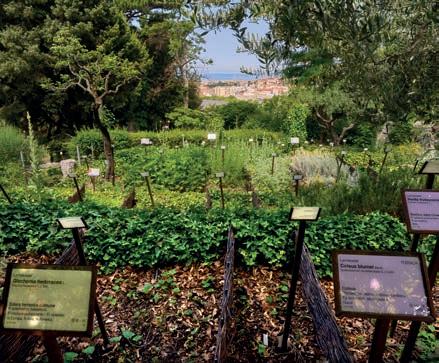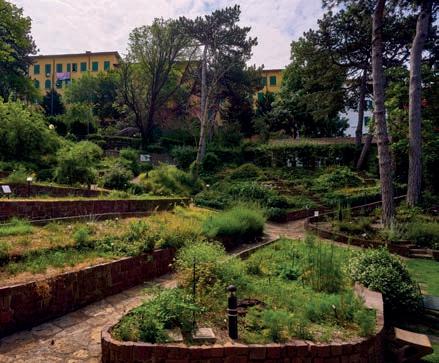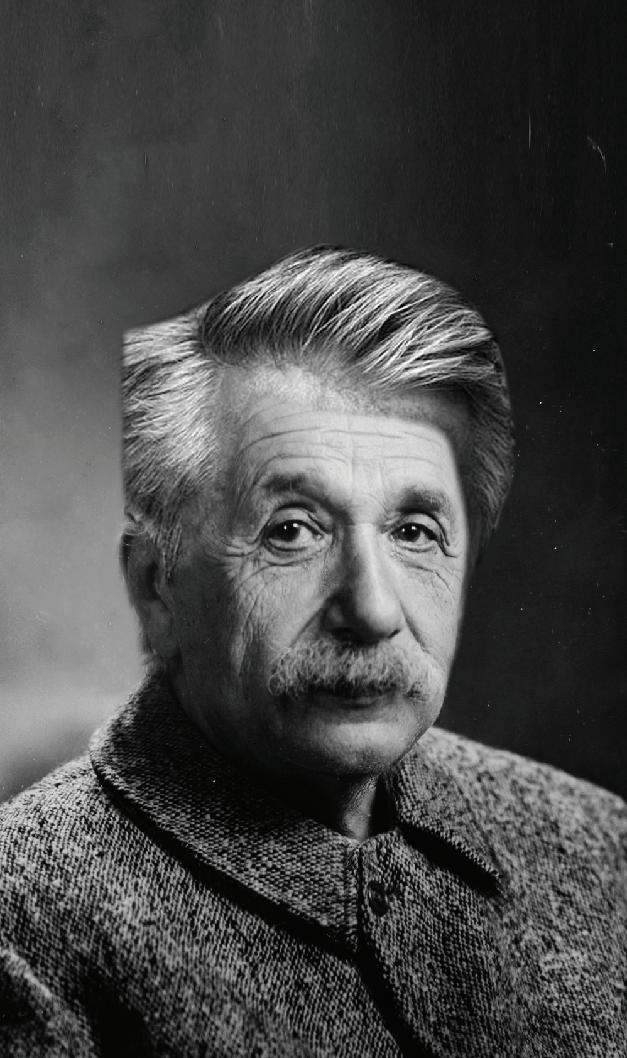
10 minute read
Passeggiando tra Ottocento e Novecento
— Strolling between the 19th and 20th centuries
di /by
Advertisement
Francesca Pitacco
La scienza tra Ottocento e Novecento a Trieste ha anche dei risvolti molto pratici. In una città la cui economia doveva crescere in maniera costante, l’applicazione delle novità che giungevano dalla ricerca scientifica era un aspetto fondamentale del progresso. Esistono pertanto dei luoghi che possono raccontare storie di scoperte eroiche, come pure di esperimenti negletti dagli stessi autori. Questi punti che fisseremo sulla mappa non hanno l’ambizione di diventare un itinerario, ma sceglierne uno o più porta a scoprire zone della città al di fuori dei classici itinerari.
Trieste non ha dedicato statue solo ai propri letterati, ma pure a degli illuminati uomini di scienzia. Joseph Ressel, la cui figura in bronzo campeggia allo sbocco del Canal grande verso il mare, fu ingegnere forestale boemo che si dedicò caparbiamente al problema del rimboschimento dell’altipiano carsico e dell’Istria. Il suo nome è tuttavia legato al progetto dell’elica per la propulsione marittima, che lo porterà a ricevere nel 1827 un permesso per la navigazione a vapore con l’elica. Due anni dopo il piroscafo Civetta solcherà il golfo di Trieste per 5 miglia raggiungendo i 6 nodi di velocità. Lo scoppio della caldaia metterà fine all’esperimento, ma la via era ormai tracciata.
Pur non seguendo un percorso di studi canonico, Osiride Brovedani, cui è dedicata una statua in Campo S. Giacomo, divenne esperto in chimica da quando –nel 1930– ottenne la concessione in esclusiva per l’Italia per la commercializzazione della pasta Fissan, che successivamente venne anche prodotta nel quartiere operaio di S. Giacomo. Deportato nei campi di concentramento di Buchenwald, Mittelbau-Dora e liberato a Bergen Belsen, Brovedani rientrò a Trieste per continuare l’attività di imprenditore in campo sanitario sia con il marchio Fissan, sia con la propria azienda che portava il suo nome. La sua storia è raccontata nel museo Casa di
Il Frenocomio austriaco a San Giovanni
Per conoscere l’incredibile storia di Carl Weyprecht merita arrivare fino al Museo dell’Antartide, che si trova all’interno dell’ex Ospedale Psichiatrico, già Frenocomio austriaco. — Carl Weyprecht’s extraordinary history is worth a trip to the Museo dell’Antartide, located in the building of the former Austrian asylum turned into psychiatric hospital of Trieste.
Osiride Brovedani retto dall’omonima Fondazione.
L’astronomia a Trieste ha radici antiche: nel 1753 venne istituita la Scuola di Astronomia e Navigazione ricordata da una targa posta sull’edificio adiacente alla chiesa di S. Maria Maggiore. La necessità di costruire un osservatorio astronomico fu molto forte e trovò sede nel 1897 in un castelletto in stile gotico quadrato sul colle di S. Vito, vicino a Villa Basevi, dove l’inquinamento luminoso della città era ancora sconosciuto. Dotato di un moderno telescopio rifrattore e altre strumentazioni all’avanguardia tuttora esistenti, non era tuttavia l’unico osservatorio della zona. Johann Nepomuk Krieger era giunto a Trieste dalla Baviera nel 1895. Nell’odierna Via Bellosguardo 46 crea Villa Pia, dedicata alla moglie, e si dedica alla selenologia, lo studio della Luna: di notte la analizza, di giorno disegna la sua superficie, realizzando degli studi qualitativamente eccellenti, tanto da fare il giro del mondo. Vengono pubblicati postumi perché Krieger muore a soli 37 anni a causa delle intemperie cui si era esposto. Dal 1973 un cratere lunare porta il suo nome.
Non ci sono solo il mare e le stelle a Trieste. Nel 1842 Bartolomeo Biasoletto e Muzio de Tommasini (a lui è dedicato il Giardino pubblico) fondano l’embrione dell’attuale Civico Orto Botanico di Via Marchesetti. Appassionati di botanica –tanto quanto lo fu Massimiliano d’Asburgo per la creazione del suo parco di Miramare– Biasoletto fu altresì farmacista in un periodo nel quale la maggior parte dei rimedi arrivava da vegetali. La sua Spezieria dell’Orso Negro esiste tutt’ora sul Canal grande e –mutata negli arredi– porta il suo nome. Si trova proprio all’angolo di Ponterosso, dove sorge l’idrometro ossia il “Null punkt”, lo zero altimetrico dell’Impero.
Per conoscere l’incredibile storia di Carl Weyprecht merita arrivare fino al Museo dell’Antartide, che si trova all’interno dell’ex Ospedale Psichiatrico, già Frenocomio austriaco, che di per sé vale la visita per gettare luce sull’evoluzione della gestione della malattia psichiatrica. Il tedesco Carl Weyprecht arrivò a Trieste diciottenne come cadetto di Marina; partecipò alla battaglia di Lissa, si trovò in Messico per recuperare Massimiliano, ma il suo nome è indissolubilmente legato alle esplorazioni polari. Nel 1872 salpa per il Mar Glaciale Artico, ma rimasto intrappolato insieme al suo equipaggio, ritornerà appena due anni dopo quando ormai tutti li davano per dispersi. Davanti alla potenza della natura Weyprecht si rende conto dell’importanza di spedizioni scientifiche internazionali, che propugnerà fino alla morte, che lo raggiunge nel 1881. È dell’anno successivo l’istituzione del primo Anno Polare Internazionale.
C’è qualcuno che delle proprie ricerche scientifiche a Trieste non vorrà mai parlare ufficialmente. Nel 1876 Sigmund Freud studia fisiologia e lavora per due mesi alla Regia Stazione Zoologica di Trieste dissezionando circa 400 anguille per indagarne l’apparato riproduttore. Lo studio che pubblica non porta ad alcuna conclusione degna di nota, se non che una volta tornato a Vienna cambierà corso di studi, diventando poi il padre della psicanalisi.
ENGLISH TEXT
Between the Nineteenth and the Twentieth century Trieste saw applied science reach its peak: the city needed a steady economic growth to ensure its progress, which meant that practical application was the most important quality of any scientific advancement. As a result, the city’s history is a patchwork of heroic findings and blatant failures, sometimes originating from the same endeavour. The map of these events is not intended as an itinerary: rather, by highlighting their existence, we hope to provide our readers with one or two useful tips for a unique, slightly unconventional tour of the city.
The statues of great men of literature are not the only landmarks paying homage to Trieste’s most brilliant minds: the bronze statue of Bohemia-born forester and inventor Joseph Ressel, for instance, looks out upon the Gulf from the mouth of Canal Grande. Known to his contemporaries for his stubborn efforts of reforestation of Istria and the Karst Plateau, he is remembered today for designing one of the first working ship propellers, which earned him a propeller patent and a test-navigation permit for steam-powered engines in 1827. Two


15
Orto botanico Botanical Garden
L’orto botanico di via Marchesetti 2 è un luogo didattico e ricreativo di proprietà del Comune di Trieste. Qui è possibile ammirare un’ampia varietà orticole locali, flora spontanea ed endemica del Friuli Venezia Giulia e delle zone limitrofe, piante acquatiche e palustri, piante succulunte grazie all’attività di conservazione, coltivazione e riproduzione. Importante la didattica sviluppata attraverso programmi sperimentali per persone con disabilità, scuole e ricreatori. –The botanical garden in Via Marchesetti 2 is an educational and recreational site owned by the Municipality of Trieste. Here you can admire a wide variety of local horticultural plants, spontaneous and endemic flora of Friuli Venezia Giulia and neighbouring areas, aquatic and marsh plants, succulent plants thanks to the conservation, cultivation and reproduction activities. Educational activities developed through experimental programmes for people with disabilities, schools and recreation centres are also important.
www.ortobotanicotrieste.it
Sigmund Freud
Nel 1876 Sigmund Freud studiò fisiologia e lavorò per due mesi alla Regia Stazione Zoologica di Trieste. — In 1876 Sigmund Freud, then a physiology student, spent two full months at Trieste’s Regia Stazione Zoologica.
years later, the modified steam-powered boat Civetta was tested in Trieste’s harbour and reached a speed of six knots before the steam conduits exploded. Despite this misfortune and consequent ban on further testing, Ressel’s pioneering endeavour had opened the way to further innovations in this field.
In Campo San Giacomo visitors will certainly notice the statue of Italian entrepreneur and philanthropist Osiride Brovedani, whose unconventional education eventually led him to chemistry, until, in 1930, he was granted an exclusive licence for the distribution of Fissan paste in Italy the Fissan factory of Campo San Giacomo opened only a few years later. After his deportation and detention in the concentration camps of Buchenwald, Mittelbau-Dora, and Bergen Belsen, Brovedani was eventually liberated and returned to Trieste to resume his distribution business, as well as the activity of his own company (which was named after him). Today the Foundation created in his name also manages the “Casa di Osiride Brovedani” museum, displaying the story of his life.
Trieste has a long-standing astronomic tradition, dating back to 1753, when the School of Astronomy and Navigation was inaugurated a date enshrined in a plaque displayed on one of the buildings adjacent to the church of S. Maria Maggiore. The first astronomical observatory was built in 1897 inside a foursquare gothic chatelet on the hill of San Vito, near Villa Basevi, where urban light pollution was completely unknown at the time. Equipped with a modern refracting telescope and other state-of-the-art astronomy instruments, the Osservatorio was the most advanced, yet not the only observatory in the area. Having moved from Bavaria to Trieste in 1895, Johann Nepomuk Krieger built Villa Pia selenology observatory (now at no.46 Via Bellosguardo) and dedicated it to his wife. He spent his nights observing the Moon, and worked on his drawings of the Moon surface during the day. His brilliant and detailed hand-drawn maps of the lunar surface were published posthumously, as Krieger died at the young age of 37, his health gravely deteriorated, possibly due to his long nightly labours at his telescope. In 1973 a lunar Crater was named Krieger in his honour. The stars and sea are not Trieste’s only source of scientific inspiration: the first embryonic plot of Via Marchesetti’s botanical garden, now Civico Orto Botanico, was sown here in 1842 by Bartolomeo Biasoletto and Muzio de Tommasini (to whom the city dedicated the homonymous Public Garden). Aside from sharing de Tommasini’s love of botany a passion so strong, it could match that of Maximilian the I, when he created the Park of Miramare Biasoletto was also a renowned local apothecary, at a time when most remedies were obtained from plants. His old pharmacy Spezieria dell’Orso Negro is still operating in its original location on Canal Grande, although it now carries his name. The building is on the corner of Ponterosso marking the Null Punkt (lit. zero point), namely the Habsburg empire’s lowest elevation point above the sea level.
Carl Weyprecht’s extraordinary history is worth a trip to the Museo dell’Antartide [Antarctic’s Museum], located in the building of the former Austrian asylum turned into psychiatric hospital of Trieste. A visit to the building itself is an unparalleled opportunity to learn about the evolution of psychiatry in this area. Carl Weyprecht arrived in Trieste at the age of eighteen, and joined the Austro-Hungarian Navy (Kriegsmarine) as a provisional sea cadet in the same year (1856). He served in the 1866 sea battle at Lissa, and participated in Maximilian the I’s rescue expedition in Mexico his most famous sea crossings, however, are his polar expeditions. He coled the 1872 Austro-Hungarian North Pole Expedition to the Arctic Ocean. His ship became trapped and was abandoned in the pack ice, and the Expedition crew eventually returned to Vienna only two years afterwards, when most thought them to be dead. Weyprecht strongly believed in the creation of a permanent international network of Arctic observation stations, which he advocated for until his death in 1881. The first International Polar Year was celebrated the following year.
There are even those who would not have wanted their scientific work in Trieste to be publicly known. In 1876 Sigmund Freud, then a physiology student, spent two full months at Trieste’s Regia Stazione Zoologica [lit. Royal Zoology Station], during which he dissected more than 400 eels. His following publication on eels’ reproductive system was inconclusive, which is probably why, upon his return to Vienna, he abandoned this line of studies and eventually became the father of psychoanalysis.











